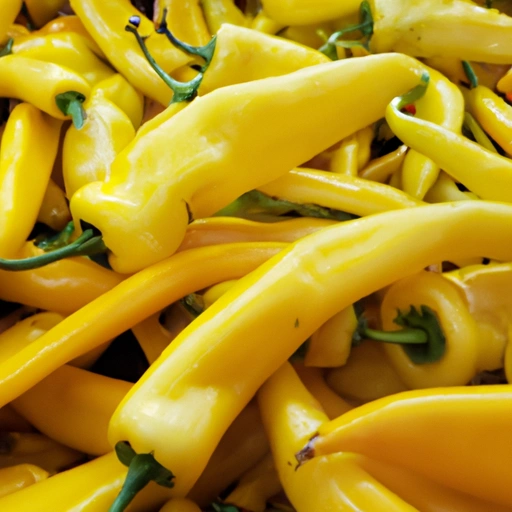Banana Pepper
Description

Banana peppers, also known as yellow wax pepper or banana chili, are a member of the chili pepper family. They are named for their long, tapered shape and yellow color, which resembles a banana. Mildly tangy and slightly sweet, banana peppers range from 0 to 500 Scoville heat units, making them one of the mildest chili peppers. This feature allows them to be a versatile ingredient in a variety of dishes without overpowering with heat.
Common uses
Banana peppers are frequently used in salads, sandwiches, pizzas, and as a pickled condiment. They can also be stuffed, roasted, or used raw for a crunchy texture in various dishes. Their mild flavor allows them to complement many ingredients without overwhelming the palate.
Nutritional value
Calories
A typical banana pepper (about 33 grams or 1.16 ounces) contains approximately 9 calories.
Protein
Each pepper provides roughly 0.4 grams (or 0.014 ounces) of protein.
Fat
Banana peppers contain a negligible amount of fat, with about 0.1 grams (or 0.0035 ounces) per pepper.
Carbohydrates
The carbohydrate content of a banana pepper is around 2 grams (or 0.07 ounces), which includes dietary fiber and natural sugars.
Vitamins
They are an excellent source of vitamin C, providing about 45% of the daily recommended intake per pepper. They also contain vitamin A, vitamin K, and various B-complex vitamins in smaller amounts.
Minerals
Minerals in banana peppers include potassium, magnesium, and iron, though in modest amounts.
Health benefits
Banana peppers are rich in vitamin C, an antioxidant that helps with the repair of tissue and the enzymatic production of certain neurotransmitters. They may also contribute to heart health due to the presence of capsaicin, albeit in low quantities compared to hotter peppers. The fiber content can aid in digestion and promote satiety, potentially assisting with weight management.
Potential risks
While banana peppers are generally safe to consume, individuals with a pepper allergy or those on a sodium-restricted diet should be cautious with pickled varieties, which can contain high levels of sodium. Overconsumption may also lead to gastrointestinal discomfort for some people.
Common recipes
Banana peppers are featured in recipes such as Greek salads, Italian sausage and pepper sandwiches, stuffed peppers, and on top of classic American-style pizzas.
Cooking methods
These peppers can be roasted, grilled, sautéed, or even enjoyed raw. Pickling is another popular method to preserve their flavor and extend shelf life.
Pairing with other ingredients
Banana peppers pair well with olives, tomatoes, feta cheese, salami, and various herbs such as oregano and basil.
Summary
Banana peppers are a flavorful, mildly spicy ingredient that can be used in numerous dishes. With their low calorie count and rich vitamin content, they make a healthy addition to any meal. Their culinary flexibility, from being pickled to stuffed, enables them to blend well within a range of recipes from different cuisines.